What role does language play in shaping our cultural identity and values? The Filipino language offers a glimpse into the nation’s cultural traditions and values. It mirrors the nation’s cultural identity, showing its values and identity. The bond between language and culture is deep, with language influencing our thoughts and societal values.
The Filipino language reflects the nation’s values, making it a key part of the country’s cultural heritage. It has been shaped by the country’s history, ethnicity, and regional differences. The language has evolved, with changes in education highlighting its importance in promoting Philippine culture.
Key Takeaways
- Language plays a critical role in cultural and humanistic development, influencing thought processes and societal values.
- The Filipino language serves as a window into the nation’s cultural traditions and values.
- Language is a reflection of a nation’s cultural traditions and values.
- The relationship between language and culture is complex.
- The Filipino language has been shaped by the country’s cultural identity, reflecting the values and identity of the nation.
- Language has a significant impact on our daily lives, from communication to education and social interactions.
The Importance of Language in Culture
Language is key in shaping our identity and community. It helps us communicate and bond with others. In the Philippines, the Filipino language brings people together, showing the country’s rich culture and values.
Language affects how we see and act towards others. For example, it can help spread stereotypes or promote understanding. It’s important to see language’s power in shaping our interactions.
Understanding language’s role in culture is vital for a united community. By valuing language diversity, we build empathy and cooperation. In the Philippines, the Filipino language symbolizes national identity, celebrating the country’s history and culture.
Understanding Linguistic Identity
Linguistic identity is how language shapes our sense of self and community. It includes values, beliefs, and practices tied to language and communication. In the Philippines, the Filipino language is a key part of national identity, reflecting the country’s history, culture, and values.
The Role of Language in Community Bonding
Language is essential for community bonding, helping us interact and work together. In the Philippines, the Filipino language unites the nation, fostering a shared identity and purpose. By valuing language in communication and community bonding, we can create stronger, more inclusive communities.
Filipino Language and Its Variants
The Filipino language is rich and diverse, showing the country’s regional values and cultural traditions. With over 130 to 195 languages spoken, it symbolizes national identity. Filipino, based on Tagalog, is the national language, along with English.
Many dialects exist, like Tagalog, Cebuano, and others. These reflect the Philippines’ geographical and cultural diversity. For instance, Tagalog is mainly spoken in Metro Manila, while Cebuano is common in the Visayas.
Tagalog, Cebuano, and Other Dialects
Tagalog and Cebuano are the top native languages in the Philippines. Tagalog has 21 phonemes, with 16 consonants and 5 vowels. It follows a CV(C) syllable structure. Cebuano, with its own grammar and vocabulary, has many Spanish and English loanwords.
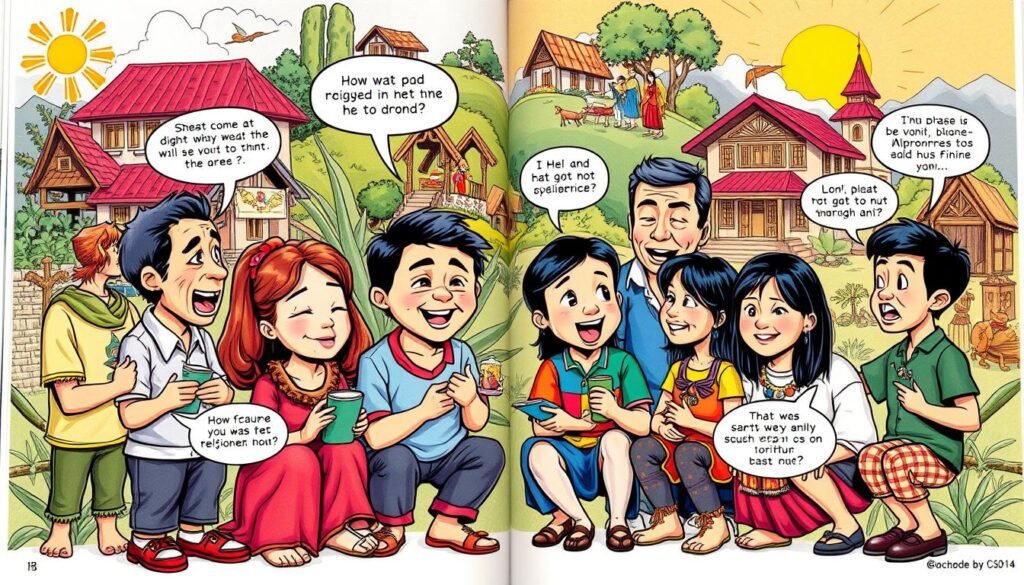
How Variants Reflect Regional Values
The Filipino language’s variants show the Philippines’ regional values and cultural traditions. For example, honorifics and polite language are more used in some areas. This shows the importance of respect and courtesy in Filipino culture. Using regional languages and dialects also helps preserve cultural heritage.
Some key features of the Filipino language and its variants include:
- Use of verb conjugations to indicate time and aspect
- Use of pronouns to indicate social status and respect
- Use of idiomatic expressions and proverbs to convey cultural values and traditions
In summary, the Filipino language and its variants are vital to Philippine culture and identity. They reflect the country’s rich history, diversity, and cultural traditions.
The Impact of Historical Context on Language
Language shows a nation’s history and culture. The historical context shapes a language’s structure and words. For the Filipino language, colonial influences have greatly shaped it. Foreign languages like Spanish and English have added new words and changed the native language.
The language evolution of Filipino mirrors the country’s complex past. It has changed to meet the needs of its speakers, showing the culture and society it’s used in. For instance, Filipino became a common language, creating a unique dialect different from local languages.
Knowing the historical context of Filipino language helps us understand its special traits. The colonial influences have made the language diverse and complex. As it keeps evolving, it will stay a key part of Filipino identity and culture.
Values Embedded in Filipino Expressions
Filipino expressions are filled with values like politeness and respect. The idea of “hiya” or shame is big in Filipino culture. It shapes how people talk to each other. Hiya means feeling ashamed or modest, helping keep things peaceful.
In the Filipino language, showing respect is key. People use “po” and “opo” to honor elders or those in charge. This shows the importance of being polite and respectful. It’s seen in greetings like “kumusta” (how are you) and “salamat” (thank you).
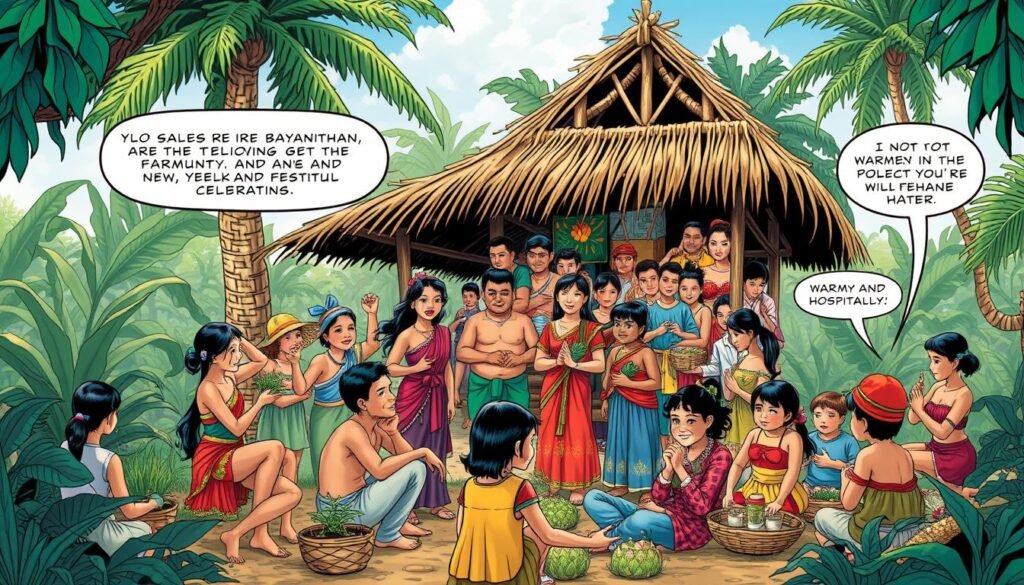
- Respect for elders and authority figures
- Politeness and courtesy in interactions
- Importance of social harmony and avoiding conflict
- Value of humility and modesty
These values show in how Filipinos talk to each other. They are key to Filipino culture and identity. Understanding these values helps us see the Filipino way of life and the role of language in their culture.
| Value | Description |
|---|---|
| Respect | Importance of showing respect to elders and authority figures |
| Politeness | Use of polite language and honorifics to show courtesy |
| Social Harmony | Avoiding conflict and maintaining social balance |
| Humility | Value of being humble and modest in interactions |
Proverbs and Sayings as Cultural Reflections
Proverbs and sayings show a nation’s emotional side. In the Philippines, they are key to understanding the national view of the world. These cultural reflections mirror the spiritual and physical actions of cultural leaders. They also show the unique ways of thinking and seeing the world of linguo-cultural societies.
People use proverbs and sayings every day. They share wisdom and values like morality, wisdom, and friendship. For instance, in the Philippines, you might hear:
- “Blood is thicker than water,” which means family is more important.
- “When in Rome, do as the Romans do,” showing the need to follow local customs.
- “An apple a day keeps the doctor away,” which encourages healthy living.
These sayings are not just for everyday talk. They also help in learning a new language in school. They are seen as a national cultural heritage that shows the country’s values and traditions.
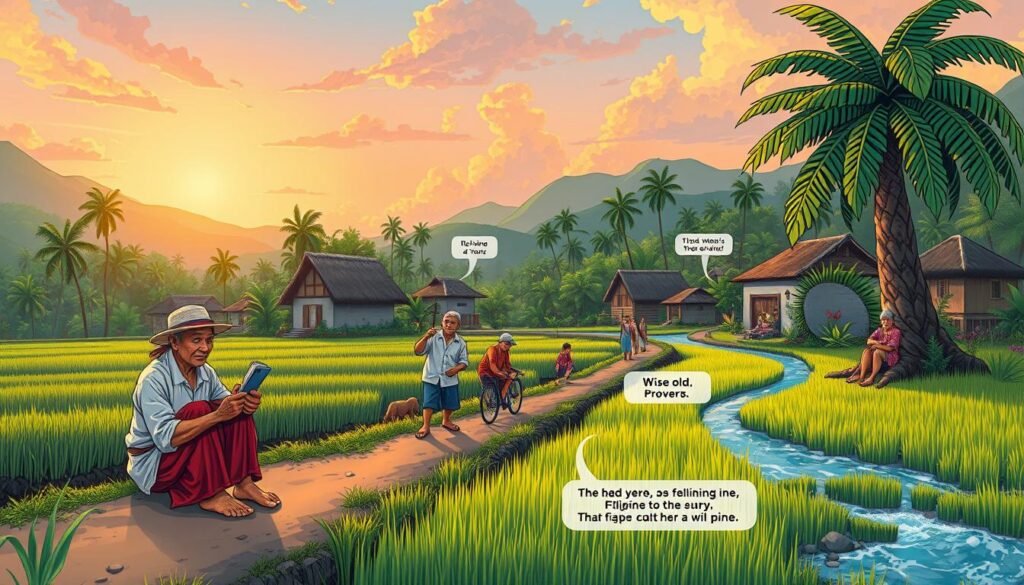
Learning and using proverbs and sayings can give us a peek into a nation’s cultural reflections. It helps us appreciate the wisdom shared by generations.
| Proverb/Saying | Meaning |
|---|---|
| Blood is thicker than water | Family ties are stronger than any other relationship |
| When in Rome, do as the Romans do | Adapt to local customs and traditions |
| An apple a day keeps the doctor away | Promote healthy habits to prevent illness |
The Role of Language in Family Dynamics
Language is key in family life, showing love, respect, and care. In many cultures, like Filipino, terms of endearment show family closeness. This is vital for strong family bonds.
Studies show that minority languages at home help kids do well. Kids who speak their native language at home often do better in school and socially. This shows how important language is in family life and for kids’ growth.
Several things affect how language is used in families. These include:
- Family size and structure
- Parents’ education and language skills
- Cultural background and values
- Where you live and language resources
A survey in Russia’s multi-ethnic area showed 91.8% of people felt their family bonds were warm. This shows language’s role in keeping these bonds strong and passing down cultural values.
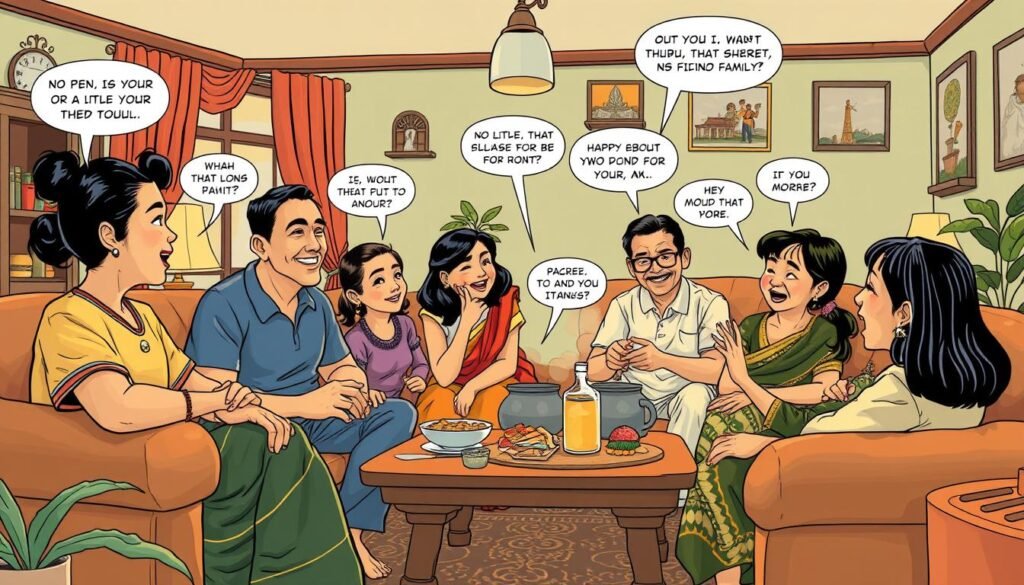
In summary, language is essential in family life. It greatly affects family ties and child development. Understanding this can help us value language diversity and keep cultural heritage alive.
| Language Use | Family Structure | Child Well-being |
|---|---|---|
| Minority language maintenance | Nuclear family | Positive impact on academic performance |
| Bilingualism | Extended family | Improved social skills |
| Monolingualism | Single-parent household | Potential negative impact on child development |
The Influence of Modern Media on Language
Modern media has changed how we talk to each other. Social media is now a big part of our daily communication. It lets us share our thoughts and connect with others easily.
Because of social media, a new way of speaking has emerged. It uses short forms, emojis, and new words. For example, language trends on social media keep changing. This shows how fast language can evolve in the digital world.
Modern media affects language in many ways. It helps us talk to people all over the world. But, it also worries some about our writing and speaking skills.
Language acquisition can be influenced by how much time we spend on social media. Some studies say too much time online can make our language skills worse.
Some main effects of modern media on language are:
- More use of short forms and acronyms
- More use of emojis and emoticons to show feelings
- Move towards more casual language

The impact of modern media on language is complex. It has both good and bad sides. As social media shapes our communication, it’s important to understand these changes and their effects on language.
Language Revitalization Efforts
Language revitalization is key to saving indigenous languages. In the Philippines, over 180 languages are at risk. It’s vital to keep these languages alive to protect cultural heritage and identity.
Education is a big part of saving languages. By teaching indigenous languages in schools, we help them stay alive. This makes kids proud of their heritage and boosts their sense of identity.
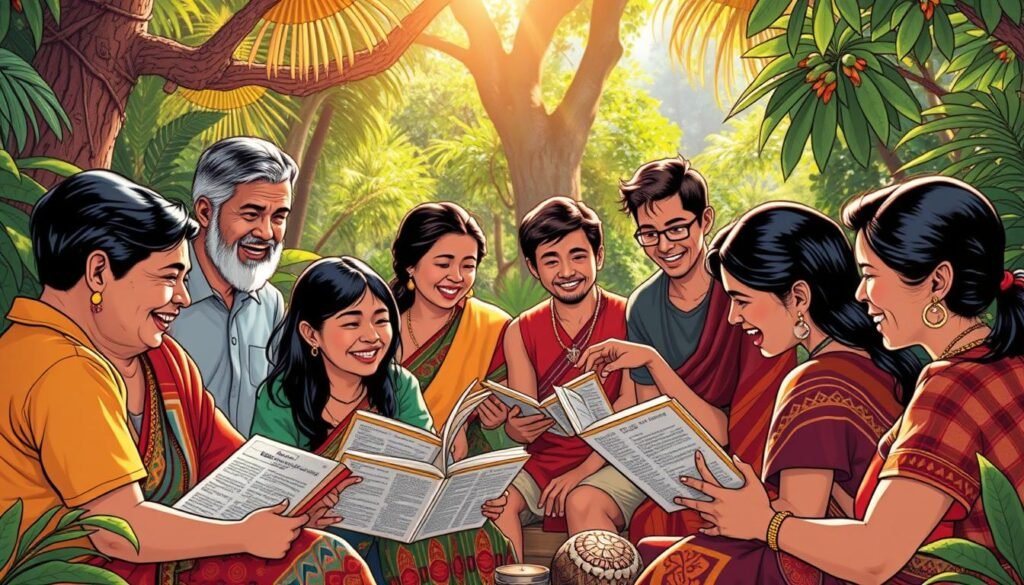
Promoting Indigenous Languages
To save indigenous languages, we need many efforts. We must support language education and use these languages in media and government. Together, we can keep these languages and cultures alive for the future.
The Role of Education in Language Preservation
Education is essential for saving languages. Teaching indigenous languages in schools keeps them alive. It also makes kids proud of their heritage and boosts their sense of identity.
Education also raises awareness about language preservation. It shows why we need to support efforts to save these languages.
Humor and Wit in Filipino Language
Filipino humor is a big part of the country’s culture. It shows cultural attitudes and values. Finding humor in daily life is key for Filipinos. They use irony and satire to talk about social and political issues.
A study on Filipino humor found that “bahala na” means accepting uncertainty with wit and strength.
Humor in Filipino culture has many benefits:
- Reduces stress
- Increases social bonds
- Boosts mental health
Filipinojokes often use wordplay, like “puns” or “pamatay na jokes.” Laughter is important in Filipino culture. It brings people together at family gatherings, meals, and karaoke.
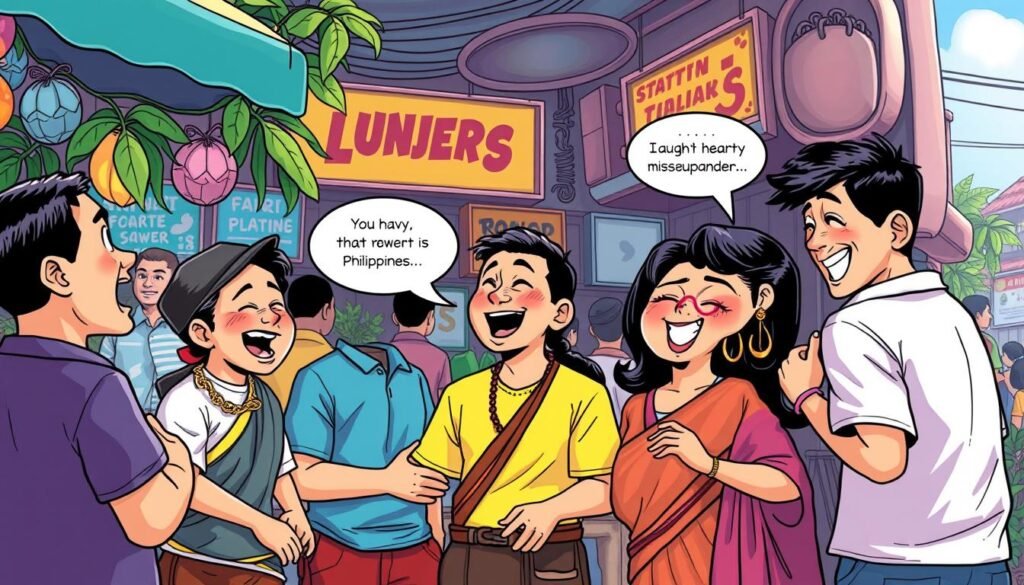
In summary, humor and wit are key in Filipino language and culture. They show the country’s cultural attitudes and values. Understanding jokes and wordplay helps us see the unique aspects of Filipino culture and its role in shaping the country’s identity.
The Language of Hospitality
The language of hospitality is key to making guests feel welcome. In the Philippines, language is important for showing welcome and building connections with visitors. Good communication is essential for top-notch service, and knowing different languages helps staff talk to guests from all over.
A study found that staff who speak many languages can make guests happier and improve service. For example, in restaurants and hotels, menus are often in several languages. This shows that staff care about guests’ language needs. Learning Baybayin can help staff connect with Filipino culture and heritage.
Language skills in hospitality bring many benefits. They include:
* Better communication with guests
* A better customer experience
* Happier employees
* Deeper cultural understanding
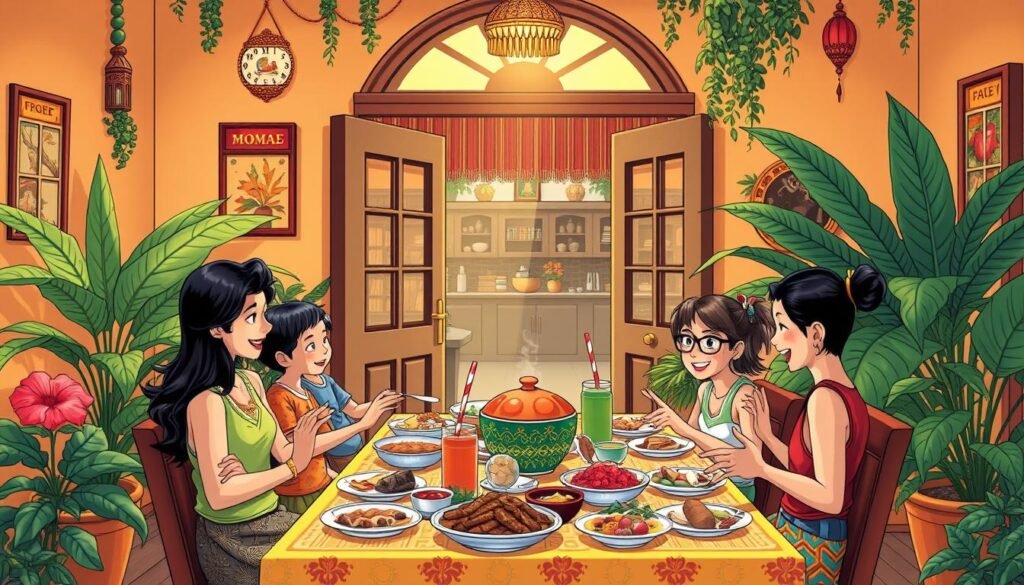
In summary, the language of hospitality is vital for a warm welcome. By improving their language skills, hospitality staff can offer great service, make connections, and improve the guest experience.
| Language | Number of Speakers |
|---|---|
| Spanish | 472 million |
| Russian | 156 million |
| Mandarin | 1 billion |
Code-Switching: A Reflection of Adaptability
Code-switching is when people switch between languages in one conversation. It shows how adaptable we are, helping us talk to people from different places. In the Philippines, this is seen in Taglish, a mix of Tagalog and English.
A study on code-switching found it’s more than just language. It’s also about accents, how we dress, and more. It helps us fit in, get ahead in our careers, make friends, and succeed by being accepted.
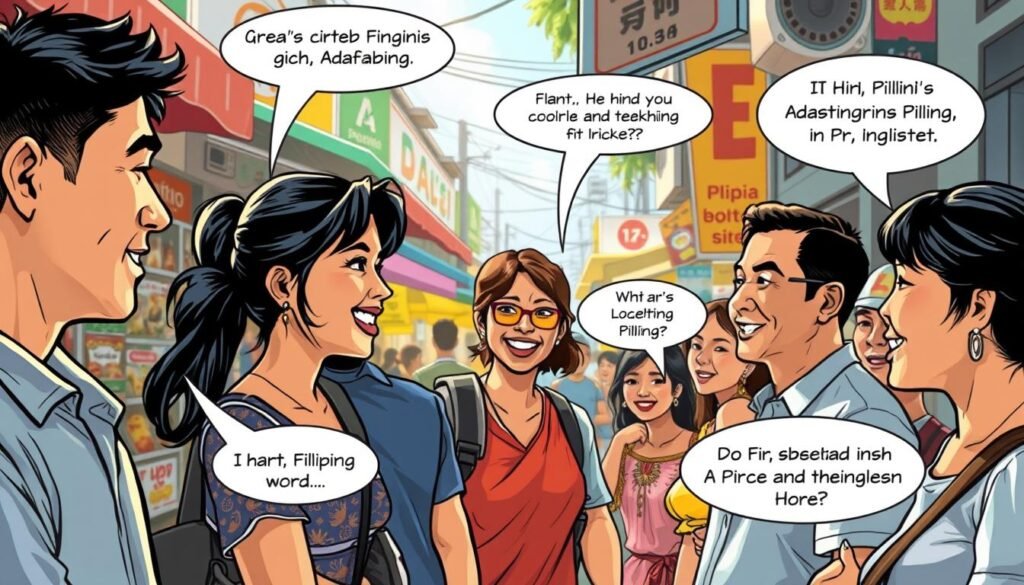
- Spanish-English code-switching in multicultural environments
- Taglish, a mixture of Tagalog and English, in the Philippines
- AAVE (African American Vernacular English), a dialect of English spoken mainly by Black Americans
These language mixes show how well we adapt to different situations. They help us communicate well with people from all walks of life.
The Impact of Language on National Identity
Language is key in forming national identity. It acts as a symbol of unity and a core part of a nation’s culture. In many countries, speaking the dominant language is seen as essential for being considered a true national. For example, in the United States, 78% of respondents think speaking the country’s most common language is important for being a true national.
Language policies help promote national identity and unity. In France, the French language is official, and efforts are made to use it in education and government. In Wales, the Welsh language is promoted as a key part of Welsh national identity, with bilingual signs and government support.
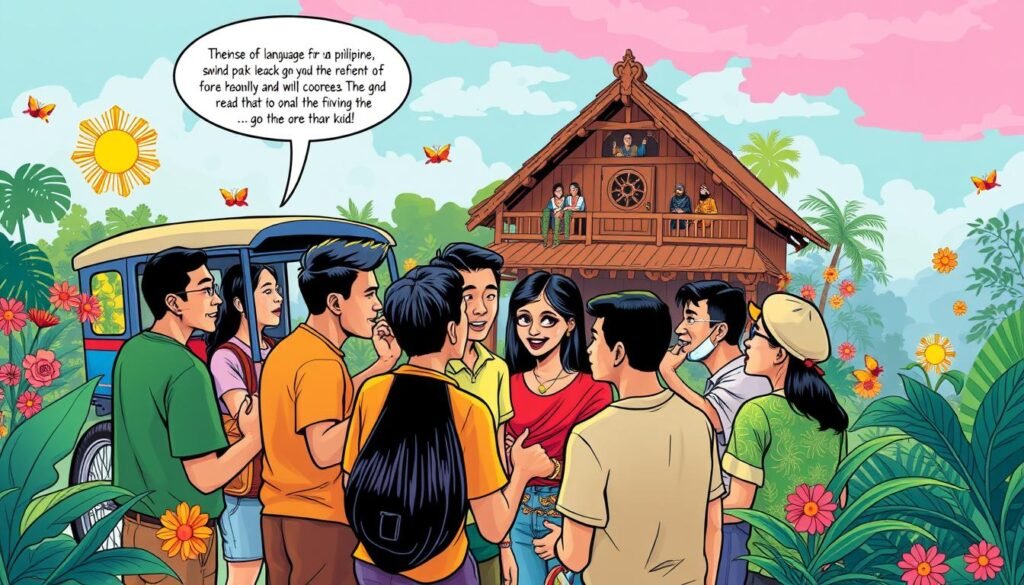
The role of language in national identity is clear. 91% of respondents across more than 20 countries believe speaking their country’s most common language is important. This shows the need for language advocacy and promotion to keep language vital in shaping national identity and unity.
Examples of national language advocacy include:
- Promoting the use of indigenous languages in education and government
- Supporting language revitalization efforts
- Encouraging the use of national languages in media and public services
Language in Religion and Spirituality
Language is key in shaping religious practices and spirituality. The words used in religious settings carry deep meanings and emotions. This affects how people feel and share their faith. For example, sacred texts and hymns in rituals bring a sense of reverence and connection to something greater.
In the world of religion and spirituality, language helps create a sense of community. Specific words and phrases share complex ideas and values quickly and clearly. Face value theory is a common way to understand religious language, seeing it as straightforward.
Some important points about language in religion and spirituality are:
- Religious terminology and its cultural relevance
- The use of sacred texts and hymns in religious rituals and ceremonies
- The role of language in shaping religious practices and spirituality

Looking into the links between language, religion, and spirituality helps us understand faith better. This understanding can lead to more empathy and respect among people of different faiths. It helps build a more united and welcoming society.
| Concept | Description |
|---|---|
| Face Value Theory | Interprets religious sentences closely to what they appear to say |
| Religious Terminology | Conveys complex meanings and emotions, influencing religious practices and spirituality |
Gender and Language in Filipino Culture
Language is key in shaping gender norms in Filipino culture. It can either support or question traditional gender roles. In the Philippines, Tagalog uses “siya” for everyone, showing a culture that goes beyond binary views. This shows the country’s values of respect and inclusivity.
Language also shows a society’s equality level. In gender, it can either support or challenge power. For example, using polite language can keep social hierarchies, while inclusive language fights for equality. A study on language and gender roles in Filipino society shows this.

The Role of Language in Gender Norms
Language shapes gender roles and expectations by changing how we think and act. Certain words can stick to old gender stereotypes, while inclusive language fights for equality. In the Philippines, language is more than just talking; it shows the country’s culture and values.
As a study oninfrastructure development and its impacton, language is vital in forming social bonds and cultural traditions.
The Future of Filipino Language
The future of Filipino language is influenced by trends and technology. It’s important to think about how these will shape the language. A survey found that 64% of people can speak both Filipino and English. Also, 83% think it’s key to grow and support the Filipino language.
Technology is playing a big role in keeping the Filipino language alive. For instance, DLSU Salita works to translate other languages in the Philippines. It’s part of the Office of the Associate Provost, focusing on language programs. Even students from other countries want to learn Filipino.
Some important facts about the future of Filipino language are:
- 83% of respondents believed it was important to actively develop and promote Filipino language
- 67% of respondents preferred to answer the survey in English due to greater familiarity
- DLSU Salita aims to offer translation services for other indigenous languages spoken in the Philippines

In conclusion, the future of Filipino language depends on trends and technology. We must think about how these will affect the language. We need to create programs that help keep the language alive for the next generations.
| Initiative | Goal | Target Audience |
|---|---|---|
| DLSU Salita | Offer translation services for indigenous languages | Language learners and enthusiasts |
| Language Proficiency Program | Promote Filipino language learning | International students and language learners |
Conclusion: Language as a Cultural Reflection
The Filipino language is more than just a way to talk. It shows the country’s values, traditions, and who they are. Polite words like “hiya” (shame) and sayings teach us moral lessons every day. This language is alive, showing the Filipino spirit.
Language and values go hand in hand, showing Filipino culture’s strength. Even as the world changes, Filipino language keeps evolving. It mixes old and new words, showing the people’s love for their culture.
Keeping indigenous languages alive is key to protecting the Philippines’ culture. By supporting minority languages and education, Filipinos can keep their cultural diversity alive. Language reflects Filipino values and will always be important to the country’s identity.
FAQ
How does the Filipino language serve as a window into the nation’s cultural traditions and values?
The Filipino language shows the nation’s cultural identity and values. It reflects the diverse traditions and values across the Philippines.
What is the importance of language in shaping community bonding and cultural identity?
Language brings people together, creating a sense of community. In the Philippines, it helps people feel connected and share a common identity.
How do the variants of the Filipino language, such as Tagalog and Cebuano, reflect the country’s regional values and cultural diversity?
Different Filipino languages, like Tagalog and Cebuano, show the country’s cultural diversity. Each has its own history and cultural significance, highlighting the Philippines’ rich heritage.
How have historical events, such as colonialism, shaped the evolution of the Filipino language?
Colonialism has greatly influenced the Filipino language. It introduced foreign words and suppressed indigenous languages. Understanding this history is key to understanding the language’s evolution.
What cultural values are embedded in Filipino expressions and language use?
Filipino language reflects values like politeness and respect. It uses honorifics and polite expressions, showing the importance of maintaining social relationships and cultural traditions.
How do proverbs and sayings in the Filipino language reflect the country’s cultural values and traditions?
Proverbs and sayings in Filipino language share cultural values. They offer insights into Filipino beliefs and traditions, highlighting the role of language in shaping identity.
What role does language play in shaping family dynamics and relationships in Filipino culture?
Language is vital in Filipino families, used for terms of endearment and honorifics. It reflects the importance of cultural traditions and family bonds.
How has the influence of modern media and technology affected the use of the Filipino language?
Modern media and technology have made Filipino communication more informal. Social media has introduced new language trends, showing the language’s evolution in the digital age.
What efforts are being made to revitalize and preserve the Filipino language, particularlly indigenous languages?
Efforts to preserve Filipino languages, including indigenous ones, are underway. Education plays a key role in these initiatives, aiming to keep the language alive for future generations.
How does humor and wit in the Filipino language reflect the cultural attitudes and values of the people?
Humor and wit are key in Filipino language, used in jokes and wordplay. They reflect the people’s sense of humor and playfulness, showing cultural attitudes and values.
What is the significance of language in the context of hospitality and connections in Filipino culture?
Language is vital in Filipino hospitality, used to welcome and connect people. It reflects the importance of hospitality and the cultural values that support it.
How does code-switching, such as the use of Taglish, reflect the adaptability and linguistic fluency of Filipinos?
Code-switching, like using Taglish, shows Filipinos’ ability to adapt and communicate. It reflects their linguistic fluency in various social and cultural contexts.
What is the role of language in shaping national identity and unity in the Philippines?
Language is key in shaping national identity and unity in the Philippines. It unites diverse regions and ethnic groups, fostering a shared sense of community.
How does language intersect with religion and spirituality in Filipino culture?
Language is deeply connected to religion and spirituality in the Philippines. It influences religious rituals and ceremonies, showing its cultural significance in spiritual life.
How does language reflect gender norms and perceptions of gender equality in Filipino culture?
The Filipino language reflects gender norms and perceptions of equality. It shapes and reinforces gender roles and expectations in society.
What are the future trends and challenges for the Filipino language, particularlly in the context of technological advancements and globalization?
The Filipino language faces both opportunities and challenges in the digital age. Efforts to preserve indigenous languages will be key in shaping its future.
Source Links
- THE FILIPINO LANGUAGE AND CULTURE – https://rjorobas.wordpress.com/2014/09/02/the-filipino-language-and-culture/
- More Than Words: How Language Affects The Way We Think – https://www.gofluent.com/us-en/blog/how-language-affects-the-way-we-think/
- PDF – http://philippinestudies.net/ojs/index.php/ps/article/download/1962/5012
- The power of language: How words shape people, culture – https://news.stanford.edu/stories/2019/08/the-power-of-language-how-words-shape-people-culture
- Culture, language and identity – Understanding racism – https://racismnoway.com.au/about-racism/understanding-racism/the-importance-of-culture-language-and-identity/
- Languages of the Philippines – https://en.wikipedia.org/wiki/Languages_of_the_Philippines
- The Filipino Language: A Comprehensive Overview – https://www.dynamiclanguage.com/the-filipino-language-a-comprehensive-overview/
- Microsoft Word – ³¢Paper-Culture and Evironment 120406.doc – https://files.eric.ed.gov/fulltext/ED496079.pdf
- HISTORY OF LANGUAGE | Historyworld – https://historyworld.net/history/Language/113
- Frontiers | Editorial: Socially Situated? Effects of Social and Cultural Context on Language Processing and Learning – https://www.frontiersin.org/journals/psychology/articles/10.3389/fpsyg.2022.855733/full
- Filipino values – https://en.wikipedia.org/wiki/Filipino_values
- Understanding Filipino traits, values, and culture | Outsource Accelerator – https://www.outsourceaccelerator.com/articles/filipino-traits-and-values/
- PDF – https://pdp.neda.gov.ph/wp-content/uploads/2017/01/07-04-07-2017.pdf
- PDF – https://revistapublicando.org/revista/index.php/crv/article/download/923/pdf_679/3667
- PDF – https://universalpublishings.com/index.php/jusr/article/download/487/943/484
- DYNAMICS OF CHANGING LANGUAGE ATTITUDES AND VALUES OF THE MODERN FAMILY – https://www.redalyc.org/journal/6377/637768467003/html/
- The Influence of Family Structure and the Role of Siblings on Early Language Development of Latino Preschool Children – https://digitalcommons.usu.edu/cgi/viewcontent.cgi?article=1475&context=etd
- The effect of social media on the language – https://www.assahifa.com/english/opinions/the-effect-of-social-media-on-the-language/
- PDF – https://globusedujournal.in/wp-content/uploads/2020/05/GE-JD195-Salwa-Saeed-Al-Harbi.pdf
- The Impact of Social Media on Language Evolution – https://www.multipostdigital.com/blog/the-impact-of-social-media-on-language-evolution
- Language revitalization – https://en.wikipedia.org/wiki/Language_revitalization
- No title found – https://oxfordre.com/linguistics/display/10.1093/acrefore/9780199384655.001.0001/acrefore-9780199384655-e-8
- The Filipino Spirit: Finding Humor in Everything – https://www.nipino.com/the-filipino-spirit-finding-humor-in-everything
- How to Use Humor and Sarcasm in Filipino: Adding a Touch of Playfulness to Your Conversation – https://fluentfilipino.com/how-to-use-humor-and-sarcasm-in-filipino-adding-a-touch-of-playfulness-to-your-conversation/
- Languages make hospitality hospitable – https://insights.ehotelier.com/insights/2018/09/02/languages-make-hospitality-hospitable/
- The best languages to learn for business and the hospitality industry – https://hospitalityinsights.ehl.edu/languages-to-learn-for-business
- The Language of Hospitality – Global Extrovert – https://globalextrovert.com/the-language-of-hospitality/
- Council Post: Code-Switching And Identity: Embracing An Intentional Approach – https://www.forbes.com/councils/forbescoachescouncil/2020/10/05/code-switching-and-identity-embracing-an-intentional-approach/
- Mastering the Art of Code-Switching – https://medium.com/@jaythomas2024/mastering-the-art-of-code-switching-e6feec5319f4
- PDF – https://hrmars.com/papers_submitted/20452/a-systematic-review-of-the-literature-on-code-switching-and-a-discussion-on-future-directions.pdf
- The Connection Between Language and National Identity – https://www.verbalplanet.com/blog/languages-and-national-identity.asp
- The Role of Language in Shaping National Identity – https://aithor.com/essay-examples/the-role-of-language-in-shaping-national-identity
- Language and Traditions Are Considered Central to National Identity – https://www.pewresearch.org/global/2024/01/18/language-and-traditions-are-considered-central-to-national-identity/
- Religious Language – https://plato.stanford.edu/entries/religious-language/
- Religion, Spirituality, and Worldview – – https://languageplease.org/topics/religion-and-spirituality/
- The Language of Gender: A Filipino and Native Hawaiian Perspective – https://medschool.cuanschutz.edu/family-medicine/about/news/disrupting-the-status-quo-blog/disrupting-the-status-quo/the-language-of-gender–a-filipino-and-native-hawaiian-perspective
- Cross-Cultural Gender-Based Investigation of Filipino and Chinese Facebook Users’ Disagreement Strategies – https://journal.qubahan.com/index.php/qaj/article/view/538
- Loving the Filipino Language | DepEd Masbate City – https://www.depedmasbatecity.com/loving-the-filipino-language/
- DLSU students support preservation of Filipino language – De La Salle University – https://www.dlsu.edu.ph/dlsu-students-support-preservation-of-filipino-language/
- Blurring the Line between Language and Culture – https://www.languagemagazine.com/blurring-the-line-between-language-and-culture/
- PDF – https://www.nepjol.info/index.php/mj/article/download/39970/30439/116263
- Answers to: ? How is language a reflection of both local culture and global culture? – https://www.classace.io/answers/how-is-language-a-reflection-of-both-local-culture-and-global-culture

